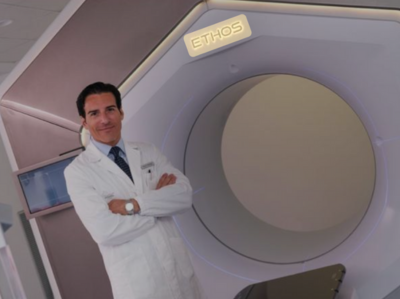Hypersight is a latest-generation technology, a ‘super eye’ capable of photographing and targeting a tumour in just six seconds, allowing the treatment plan to be recalculated with extreme precision and unprecedented speed. The new software has been acquired for the first time in Italy by the Department of Advanced Oncological Radiotherapy of the Irccs Sacro Cuore Don Calabria in Negrar (VR), a national reference centre in the oncological field, with which the University of Brescia and ASST Spedali Civili di Brescia operate under an agreement. The Department is headed by Prof. Filippo Alongi, Professor of Diagnostic Imaging and Radiotherapy at our University.
The new technology integrates and enhances Ethos, an artificial intelligence-guided radiotherapy machine, already in use since 2022, and defined as ‘adaptive’, i.e. capable of recalculating a new treatment plan at each session, in real time, based on changes in the tumour mass and anatomical variations that may occur during treatment. The use of the new software makes it possible to pinpoint the tumour site perfectly and treat it with extreme accuracy and precision, without damaging healthy tissue and in a shorter time, helping to reduce the duration and number of sessions and cut waiting lists.
“The new instrument is a guide to precision treatment in real time, an important technological implementation recently introduced at Negrar” - explains Prof. Alongi. “Now it is as if we had a ‘super viewfinder’ on board to target and hit the site of the tumour disease to be treated, identifying it and hitting it with extreme precision and sharpness in just a few seconds. In fact, the device makes it possible to optimise the effectiveness of the system by allowing the new treatment plan to be recalibrated in just a few seconds and in real time, i.e. when the patient is on the couch, on the basis of changes in the position, shape or size of the tumour, which in any case occur from session to session. This also proves to be a valuable support for the clinician in defining personalised treatment plans on a day-to-day basis for each case, especially in the most fragile patients and the most complex conditions. The new instrument also makes it possible to treat patients who are unable to stay under the machine for a long time, such as the elderly and obese, or those with pacemakers or metal prostheses, where the images produced by the system do not interfere with treatment. This integrated system, which is faster and extremely precise in its anatomical visualisation, makes it possible to irradiate the tumour mass in a tailored manner, safeguarding the surrounding healthy tissues, reducing the duration and number of sessions, and cutting down waiting lists and indirect costs for patients and their families to the hospital, especially for those coming from other locations or distant regions. Modern technology makes it possible to treat many early-stage or metastatic solid tumours, such as those of the prostate, lung, pancreas and liver, in an average of five sessions, painlessly and in just a few minutes. Above all, adaptive and ultra-precision radiotherapy can also be used in the event of tumour recurrence, re-intervening patients who have already undergone previous radiotherapy and who today would have no other treatment options”.


